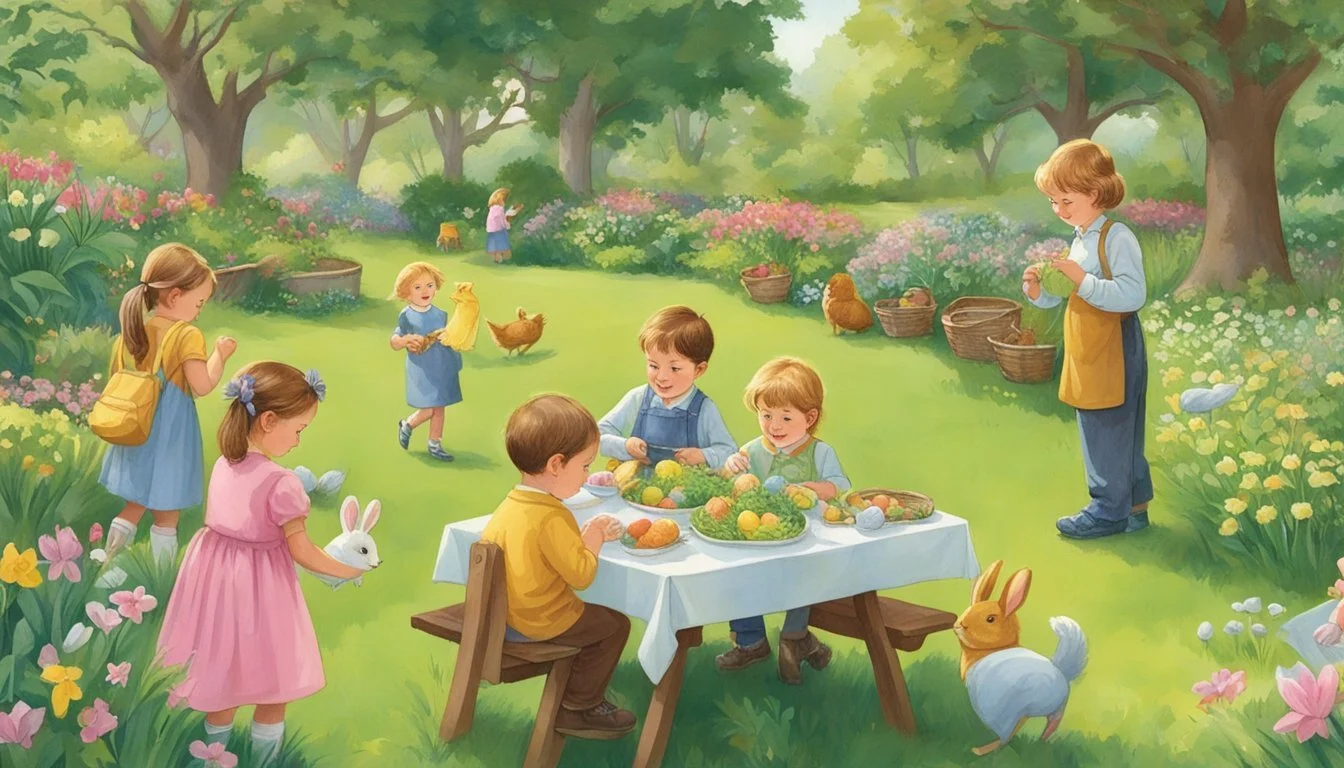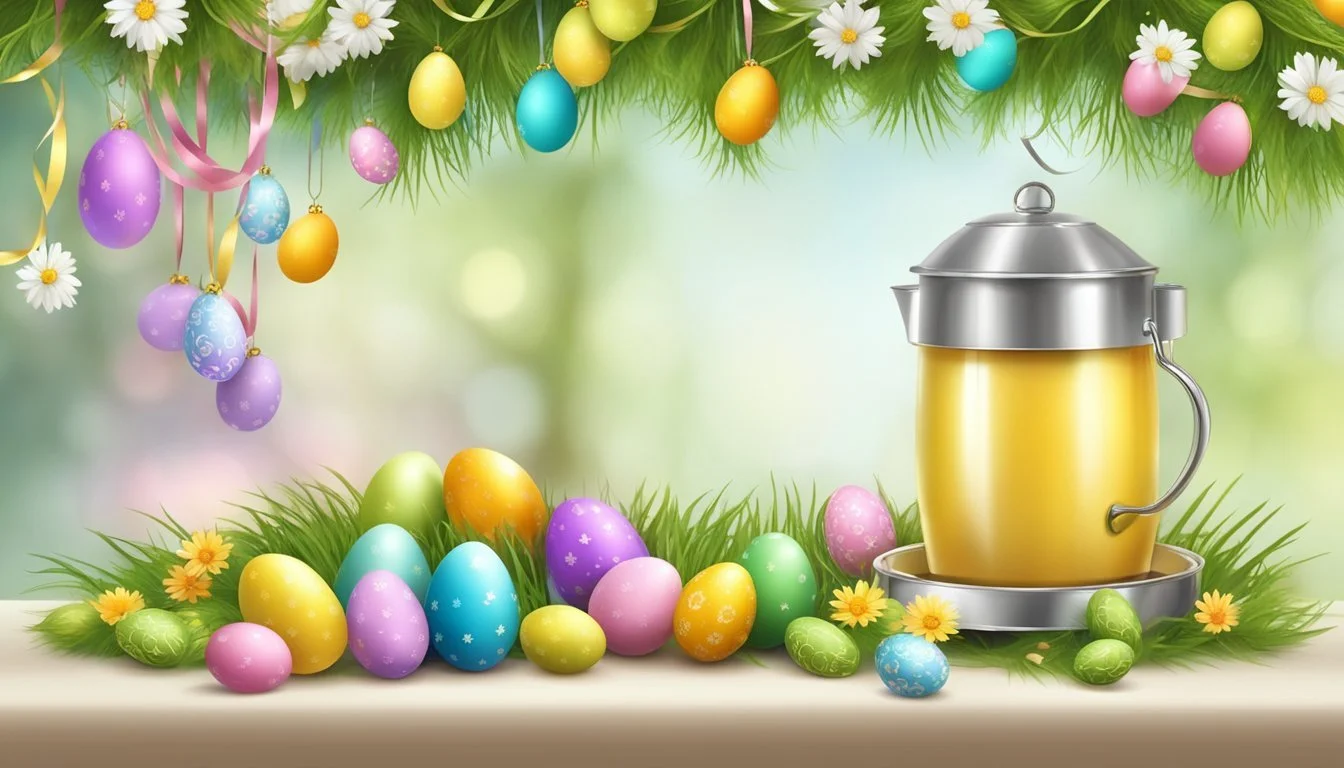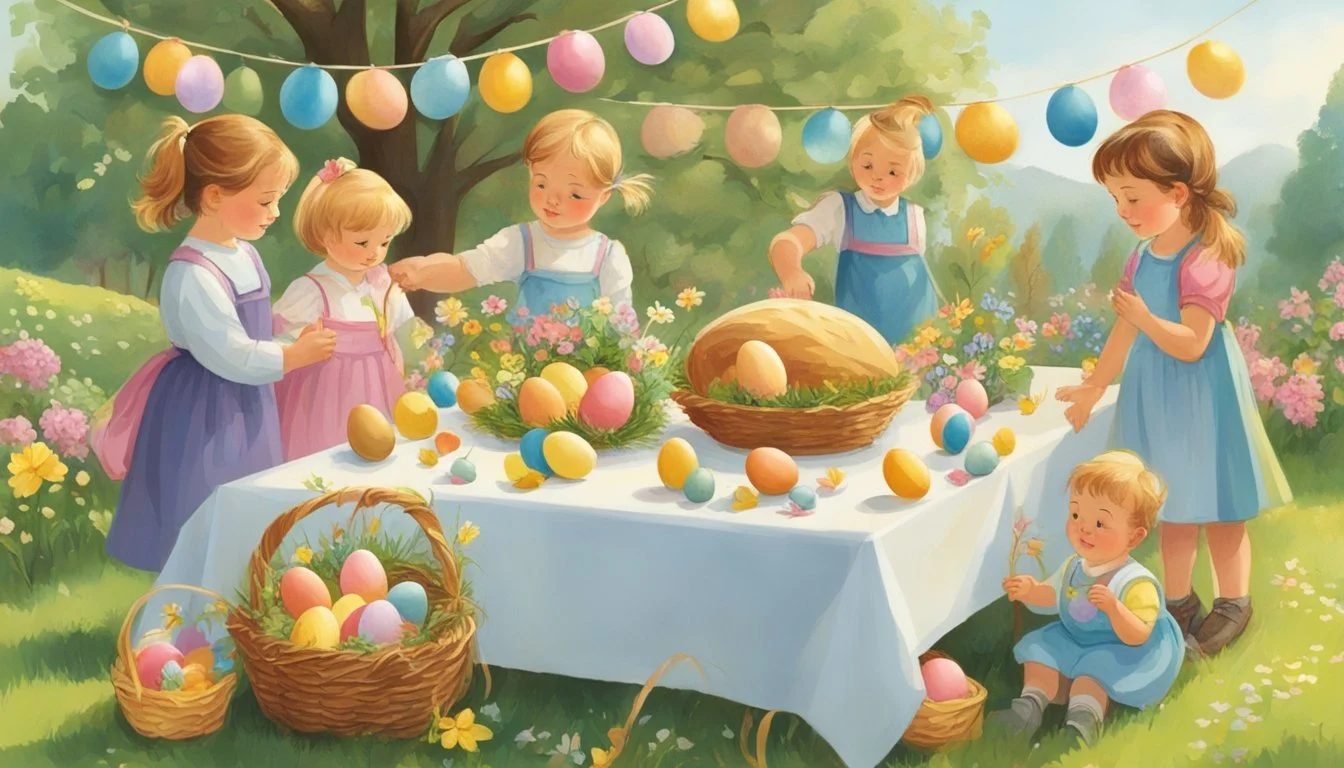German Texan Traditions for Easter
Celebrating with a Unique Blend of Cultures
Easter celebrations among German Texans blend unique cultural heritages with the regional flavors of Texas, culminating in a distinct way of observing this important Christian holiday. German settlers brought their Easter customs to Texas in the 19th century, mixing them with local traditions to create a rich tapestry of celebration. The fusion of these customs manifests through church services, festive foods, and communal activities that underscore the German Texan identity while also embracing the wider cultural context of Easter in the United States.
Community plays a central role in German Texan Easter traditions. Common customs include the Easter egg hunt, which has roots in the German folklore tale of the Osterhase, or Easter hare, that lays colored eggs as symbols of new life and fertility. The eggs, often decorated with intricate patterns, are hidden for children to find, uniting families and neighbors in a playful search that symbolizes the joy of the season. Alongside the egg hunts, traditional foods such as lamb, pretzels, and sweet breads grace tables, all bearing significance tied to both German heritage and the celebration of spring and renewal.
Historical Origins of German Texan Easter Traditions
Easter traditions in Texas with German roots are a vibrant tapestry of cultural and religious practices, reflecting both the historical journey of German immigrants and their Christian faith.
Influence of German Custom on Texan Celebrations
German settlers brought with them to Texas a wealth of cultural traditions that significantly shaped local Easter celebrations. One of the most visible symbols is the Easter Egg, representing fertility and new life in tune with the spring season. These emigrants from Germany maintained their custom of decorating eggs and brought the Osterhase, or Easter Hare, which gave rise to the Easter Bunny, an icon now synonymous with the holiday in Texas.
Egg painting and decorating
Easter Hare (Osterhase) tradition leading to the Easter Bunny
As the years passed, these practices not only persisted but also blended with Texan culture, showcasing a unique combination of German heritage with the American spirit.
Christianity and Easter: From Germany to Texas
The religious aspect of Easter, central to its celebration, commemorates the resurrection of Christ. This belief was firmly rooted in the settlers' Christian faith, which they carried from Germany to Texas. The Lenten season leading up to Easter is observed as a time for reflection and penance, culminating in a joyous celebration of the belief in Christ's victory over death.
Christian observances:
Lent: A period of 40 days of fasting and meditation
Easter Day: Celebrating the resurrection of Jesus Christ
These traditions established by the early German Texans continue to shape Easter festivities—religiously and culturally—retaining the essence of their origin while continuing to evolve within Texan society.
Easter Week Celebrations and Rituals
In Texas, where German heritage runs deep, certain Easter traditions echo those of Germany with a unique Texan flavor. Here, Easter Week is observed with a series of solemn rituals and joyous celebrations that reflect the blend of cultures.
Maundy Thursday and Green Thursday Traditions
German Texans observe Maundy Thursday, or Green Thursday, with church services that commemorate the Last Supper of Jesus Christ. In some communities, people might eat green-colored foods as a nod to the traditional German practice on this day.
Church Service: Typically includes the washing of feet, symbolizing Jesus's act of service.
Good Friday Observances
Good Friday marks the somber remembrance of Jesus Christ's crucifixion. Services are usually reflective, with emphasis on the passion and suffering of Christ.
Processions: Some congregations carry crosses in processions to signify the journey to Calvary.
Church Attendance: Devotees observe silence and solemnity, with many attending a special church service.
Easter Sunday: Resurrection Celebrations
Easter Sunday in German Texan communities celebrates the Resurrection of Jesus Christ with much fanfare. After attending sunrise services, families gather for festive meals and share in traditions such as the Easter egg hunt.
Sunrise Service: Churches hold early morning services to commemorate the resurrection.
Community Gatherings: Often include Easter egg hunts and sharing of meals.
Symbolism and Decorative Customs
In German Texan Easter celebrations, symbolism plays a pivotal role, with a variety of customs that are rich in meaning and history. Decorative rituals, often deeply rooted in the intertwining of cultural and religious beliefs, emphasize themes of fertility, new beginnings, and resurrection.
Easter Eggs: From Osterhase to Osterei
The Osterhase (Easter hare) is a central figure associated with Easter eggs, known as Osterei. This tradition, which has spread globally, has the hare bringing decorated eggs as a symbol of new life. Painted Easter eggs embody this tradition, serving not only as decorations but also as representations of the renewal and fertility of spring. German Texans often partake in the custom of painting eggs, embracing the element of artwork and creativity that these decorations bring to the season.
The Easter Lamb and Cross Imagery
The Easter lamb, which symbolizes innocence and sacrifice, is a significant figure in German Texan Easter iconography. Decorations often feature the lamb alongside the cross, an intersection of faith-based and springtime imagery. This symbol is common in baked goods as well, with lamb-shaped cakes being a traditional treat during the Easter festivities.
Spring and Resurrection Symbols
More broadly, the onset of Easter in the German Texan community heralds the beginning of spring with various animals and symbols serving as reminders of the season's spirit of rejuvenation. Decorative customs showcase items such as chicks and bunnies, augmenting the overarching themes of fertility and renewal tied to the Easter holiday. The use of these symbols reflects the strong link between the natural reawakening of spring and the concept of resurrection that is at the heart of Easter's religious significance.
Easter Foods and Feasts
In German Texan Easter celebrations, the dining table comes to life with an array of traditional meats, sweet treats, and customary sauces. These foods not only signify the cultural blend, but also echo the historical German roots adapted to the Texan palate.
Traditional Easter Lamb and Fish Dishes
Easter Lamb is a centerpiece in German Texan Easter meals. It's often prepared roasted, echoing the German custom, and is seen as a symbol of Christ and new beginnings. Fish, too, holds a special place due to its symbolism of Christ and is commonly enjoyed on Good Friday. Germans in Texas have adapted their culinary methods to incorporate local ingredients, preparing dishes like smoked lamb chops or grilled fish with local herbs.
The Role of Sweets and Chocolate
Sweets and chocolate play a festive role in Easter traditions. Chocolate eggs and bunnies are a nod to German customs, widely adopted by Texans. Home-made or artisanal chocolates are preferred, giving a personal touch to these sweet gifts. Traditional German Osterlamm (a lamb-shaped cake) is a cherished sweet commonly found on the Easter dining table.
Green Sauce and Easter Meals
Green Sauce, known as Grüne Soße in Germany, is a staple condiment featuring a blend of seven herbs, sour cream, and eggs. German Texans serve this refreshing, herby sauce alongside their Easter meals, especially with fish and potatoes. It acts as a symbolic dish for spring, reflecting freshness and renewal associated with the season and the Easter festival.
Festive Activities and Symbols
Easter in German Texan communities is celebrated with a rich tapestry of traditions rooted in both German heritage and Texan culture. The festivities encompass a blend of religious symbolism and folk customs, showcasing a variety of activities and symbols that reflect the duality of their origins.
Easter Fires and the Easter Bunny
Easter Fires (Osterfeuer): In German Texan Easter celebrations, the Easter fire or Osterfeuer is a captivating tradition. Large bonfires, known as Easter bonfires, are lit on the eve of Easter Sunday. These fires symbolize the end of winter and the welcoming of spring, embodying themes of renewal and rebirth.
Easter Bunny (Osterhase): Another central figure is the Easter bunny. Traditionally depicted as a hare rather than a rabbit, this character is responsible for delivering Easter eggs to children. The Easter bunny, or Osterhase, is a beloved symbol of the holiday, seamlessly merging German folklore with local Texan Easter customs.
Easter Egg Trees and Easter Fountains
Easter Egg Trees (Ostereierbaum): The Easter egg tree, or Ostereierbaum, is a charming custom where trees and shrubs are adorned with painted eggs. These vibrant decorations are often seen gracing homes and gardens, adding a pop of color and signifying new life during the Easter season.
Easter Fountains: In some German Texan regions, fountains are decorated with greenery, flowers, and eggs – a practice known as Osterbrunnen. This ritual highlights the importance of water as a symbol of life and purity, further underlining Easter's themes of rebirth.
Regional Variations: From Sorbs to Frankfurt
Sorbs: Among the Sorbian community in Texas, descended from a Slavic ethnic group, Easter customs hold a distinctive place. They maintain unique traditions such as intricate egg painting, with patterns that carry specific meanings and are passed down through generations.
Frankfurt: In contrast, German Texans with roots in the Frankfurt area might integrate local German customs into their Easter festivities. Frankfurt's own Easter practices could influence the ways in which German Texans observe the holiday, from the foods they prepare to the specific ways they decorate Easter fountains and participate in communal activities.
Celebrations Specific to German Texans
In Texas, the melding of German tradition with local customs has led to unique Easter celebrations. These festivities not only honor the deep-rooted heritage but have also become a vital part of the wider community's observance of the holiday.
Legacy of German Traditions in Texas
German Texans maintain a cherished legacy of cultural traditions, especially during Easter, which includes a distinctive blend of German customs intertwined with Texan influences. German Easter traditions such as decorating eggs and the Easter Egg Tree have become focal points of the holiday, carrying on the practices of forebears who settled in Texas towns like Fredericksburg and New Braunfels. Here, one can find the public holiday infused with a strong sense of Christianity, where Christians both honor the past and celebrate the present.
Decorated Eggs and Easter Egg Trees: A symbolic representation of life and resurrection, intricately decorated eggs and trees adorned with these eggs are a sight to behold in many German Texan households and public spaces.
Easter Bunny Nests: Drawing from German folklore, these are created to delight children and adults alike, often becoming part of community hunts.
Community Events and Church Services
Community gatherings and church services represent the heart of Easter celebrations for German Texans. These events are where individuals come together to both worship and celebrate, reflecting the communal aspect of the holiday.
Church Services: Central to the observance of Easter, church services are held with sermons and hymns that often feature German language or influences.
Location Service Type Notable Features Fredericksburg Traditional Service German hymns, Lutheran tradition New Braunfels Community Mass Eclectic blend of Texan and German customs
Community Events: Ranging from Easter markets selling traditional German treats and crafts to community-driven Easter bunny nest creations, these events offer a rich tapestry of shared experiences.
Event Description Importance Easter Markets Sale of decorated eggs, crafts, and traditional foods Economic and cultural significance Community Nests Public Easter bunny nest building Engages families and continues folk traditions
German Texans have expertly interwoven their heritage with local customs to create an Easter celebration that is profoundly enriching and unique to the Texan cultural landscape.







